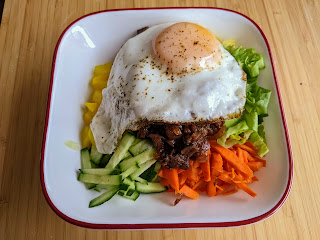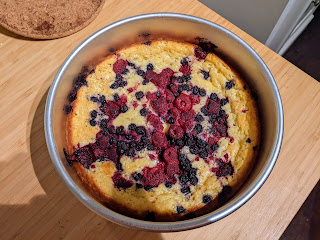I played a bit fast-and-loose with the vegetables and toppings, but you can get away with doing that with dishes like this. Aaron recommended carrots, zucchini, shiitake mushrooms, lettuce, salted daikon with gochugaru, soy bean sprouts, cucumbers, saucy ground beef, and a sunny side up egg. We didn't have the zucchini, bean sprouts, or any fresh daikon, so we swapped them out for bell pepper and danmuji (pickled daikon). And we swapped out the ground beef for chopped, thinly sliced beef. Really though, I think as long as you have rice, at least a few different veggies, some protein (meat, tofu, tempeh, seitan, etc.), and an egg... you're good to go! Make it what you want.
Bibimbap
Slightly adapted from Aaron & Claire
Ingredients
Vegetables
All of the veggies should be considered optional, but you should try to make sure you have at least four different things if possible.- shiitake mushrooms, sliced
- cucumber, julienned
- bell pepper, thinly sliced
- lettuce, cut into bite-sized pieces
- cabbage, shredded
- corn
- fresh daikon or danmuji, julienned
- coarse sea salt
- fine gochugaru
- carrot, julienned
- zucchini, julienned
Beef
- 1 onion, chopped
- 4 green onions, chopped
- 1 Tbsp. sugar
- 1 Tbsp. minced garlic or garlic paste
- 5 Tbsp. light (regular) soy sauce
- 3 Tbsp. oyster sauce
- 1 Tbsp. sesame oil
- 200g beef, ground or thinly sliced
- pepper, to taste
Sauce
- 3 Tbsp. gochujang
- 1 Tbsp. corn syrup
- 1 Tbsp. water
Assembly
- cooked rice (~3/4 c. per person)
- sesame oil (1 tsp. per person)
- eggs (1 per person)
Directions
Vegetables
- If you're using dried mushrooms, soak them in hot water for a while before you start cooking. Sometimes they can take a long time to soften up. If you're using fresh, you can just slice them while prepping the rest of the veggies.
- Chop all your veggies.
- If using fresh daikon, sprinkle some salt on it and let it sit for at least 15 minutes. Then drain off any liquid and sprinkle with gochugaru.
- Cook the carrot in a little oil until slightly softened. Sprinkle with a little salt if you wish.
- Give the zucchini the same treatment. Be careful not to overcook it!
- Cook the mushrooms in a little oil too. Season with sesame oil, pepper, and either salt or soy sauce. (I like soy sauce.)
- Set the veggies aside while you get everything else ready.
Beef
- Combine onion, green onion, sugar, garlic, soy sauce, oyster sauce, and sesame oil in a bowl.
- Cook beef in a little oil and season with some pepper.
- Pour in the sauce and cook over medium-low until most of the liquid has evaporated.
Sauce
- Combine gochujang, corn syrup, and water and mix well.
Assembly
- Put some rice in a bowl and drizzle with a teaspoon of sesame oil.
- Top with veggies. Try to keep each veggie separate so you get lots of different colours each in their own section.
- Place a spoonful of beef in the centre.
- Fry an egg1 and place it on top.
- Serve with sauce on the side.
- Instruct diners to add some sauce to their bowl and then mix everything up before eating.
1 Sunny side up is generally preferred. The runny yolk acts as a sauce for the rice and veggies. I like to do "sunny side up in the shade" where you cover the pan so that the egg steams a little bit and sets the thin film of albumen over the yolk. This makes the yolk look a little cloudy, so it's not as aesthetically pleasing, but I don't mind that. If you're not big on runny yolks, you could have your egg scrambled or boiled instead. Or if you don't like fried eggs, soft poached eggs would also work quite well. Much like with the vegetables, there's a lot of flexibility here. Back












